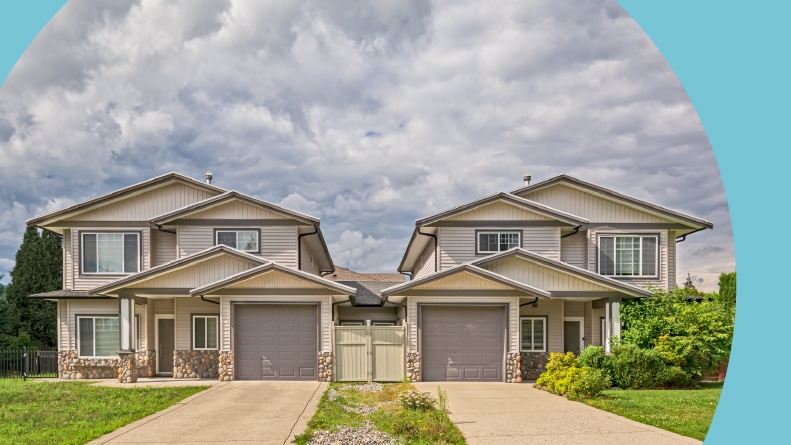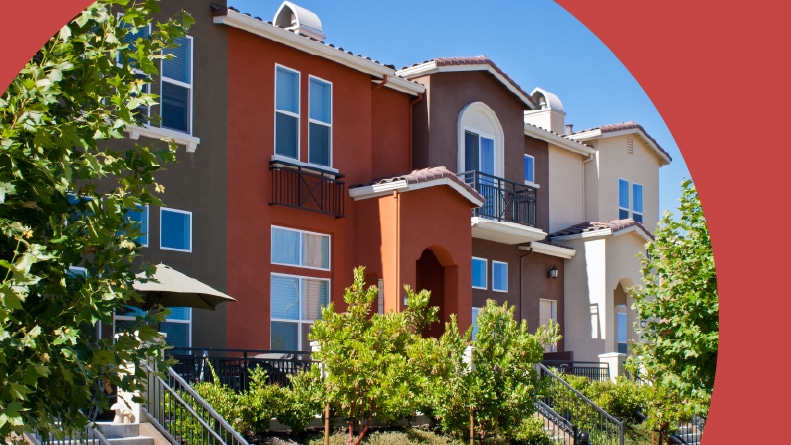Many homebuyers have misconceptions about what it’s like to live in an attached home. So, when searching for their next perfect place, active adults may overlook this housing option and miss out on all the potential it has to offer! Let’s explore the real advantages of attached homes in 55+ communities and the reasons why they’re becoming an increasingly popular choice for retirees.
What Is an Attached Home?

An attached home shares at least one interior wall with its neighbor, making it literally connected to the house or houses beside it. These types of homes come in various configurations. Some are traditional side-by-side residences, such as duplexes, while others are larger structures, including condominiums. In some cases, only a garage wall is shared between the two properties. The wide variety of possible configurations allows attached homes to suit people with varying privacy preferences.
Why Retirees Choose Attached Homes

Many retirees choose attached homes because they offer strong value. These properties are generally more affordable than detached single-family homes, making them an appealing option for those on a fixed budget who still want a comfortable, well-maintained living space.
This affordability also opens the door to 55+ communities that retirees may not have been able to consider otherwise. These communities often feature abundant amenities and built-in opportunities for social engagement, helping residents stay active, connected, and fulfilled throughout their retirement years.
Attached Homes in 55+ Communities

Many active adult communities across the country have a mix of attached and detached home options. When attached homes are present, they’re typically located closer to community centers, clubhouses, pools, and other amenities. Many retirees find the strategic location of these homes appealing. In exchange for sharing a wall, retirees can reduce their driving, participate more easily in community activities, and get more exercise through easy walking.
Considerations for Attached Home Living

While there are several advantages to attached homes, it’s still important to understand the potential downsides and challenges. Due to the diversity of attached homes, it’s essential to note that these problems may exist in one location but not in another.
Shared Walls and Privacy
The most common concern people have about attached homes is the potential for noise to transfer from one house to the next through the shared wall. However, this issue isn’t always as big a problem as it seems. Modern construction is very good at reducing the transmission of sound. Today’s attached homes are significantly better at soundproofing than older ones are.
As an additional way to reduce sound transfer, modern builders often design floor plans to minimize noise concerns. For example, the front doors of attached homes are usually placed further apart, providing greater privacy when coming and going. While these features don’t eliminate the noise transfer between homes, they do greatly minimize it.
Accessibility Features
Condo-style attached homes require careful consideration of accessibility features. Rather than being able to walk up their door from the curb, retirees who live in this style of home must navigate stairways or elevators. As mobility can become an issue with age, the retirement property you choose should have well-maintained elevators, adequate lighting, and any relevant safety features. For those worried about mobility who want to live in a condo-style home, ground-floor units are a great option.
Storage Space
Although home sizes vary, attached homes are typically more compact than detached houses, resulting in less storage space. However, this isn’t the drawback that it may seem to be. Many retirees find that forcing themselves to downsize allows them to declutter and live a simpler life. Whether this fits your lifestyle is a personal decision, so be sure that the available space in any home you’re considering meets your needs as you tour the property.
The Retirement Advantages of Attached Homes

For retirees, attached homes offer several advantages that fit naturally with the active adult lifestyle. From lower maintenance demands to greater affordability and easy access to community amenities, these homes support a lifestyle focused on leisure and convenience.
Minimal Maintenance
One of the most significant advantages of attached homes is the reduced maintenance burden. Many homeowners’ associations (HOAs) cover exterior upkeep, snow removal, and lawn care. These tasks become increasingly burdensome with age, so removing the responsibility of taking care of them is an enormous benefit.
Energy Efficiency
The shared wall or walls of an attached home are adjacent to an insulated and climate-controlled space, rather than to the outside. This provides a greater deal of insulation during hot summers and cold winters, allowing for substantially lower heating and cooling costs. This is particularly valuable for retirees looking to move to areas with extreme climates.
Financial Benefits
We’ve already discussed the lower purchase price of an attached home. Depending on how assessors classify them, they may also be eligible for reduced property taxes. When combined with energy efficiency and reduced maintenance costs, these savings can enable more discretionary spending from retirement funds.
Social Opportunities
The proximity of residents in attached home neighborhoods encourages deeper community connections. With more residents living near you, you’re more likely to encounter your neighbors as you go on walks or spend time in your yard. This is great for retirees who wish to make friends and maintain an active social life.
Prime Community Access
Attached homes in 55+ communities are typically situated near central amenities, including clubhouses, fitness centers, pools, and tennis courts. This provides easy access to activities, classes, and social events, encouraging an active lifestyle and reducing the need for driving.
FAQ: Attached Homes for Retirees
1. What is an attached home?
An attached home is a residence that shares at least one common wall with a neighboring unit. In 55+ communities, this includes duplexes, townhomes, villas, and some condominiums.
2. Are attached homes good for retirees?
Yes. Attached homes are popular among retirees because they offer lower maintenance, strong value, and convenient access to community amenities—often at a more affordable price point than single-family homes.
3. Are attached homes cheaper than single-family homes?
In most markets, attached homes are more affordable than detached homes. They also typically come with lower utility costs due to shared wall insulation, which saves retirees money in the long term.
4. Are attached homes noisy?
Modern attached homes are built with advanced soundproofing, minimizing noise transfer. Many builders also place quieter spaces (such as closets and garages) against shared walls to further reduce sound.
5. Do attached homes come with less storage?
Attached homes may offer less storage space than single-family homes, but many retirees prefer this option as a way to downsize and simplify their lives. Many units also include garages, lofts, or exterior storage closets.
6. Do HOA fees cover maintenance for attached homes?
In most 55+ communities, HOA fees cover exterior maintenance, landscaping, roof repairs, and/or pest control. This makes attached homes ideal for retirees who no longer want to worry about home upkeep.
7. Are attached homes energy efficient?
Yes. Because they share at least one wall with another heated/cooled home, attached residences often require less energy for heating and air conditioning, leading to lower utility bills.
8. Do attached homes offer enough privacy for retirees?
Many retirees report no loss of privacy. Thoughtful design elements, such as offset entrances, soundproof walls, fenced patios, and private driveways, help attached homes feel just as private as detached options.
9. Are attached homes available in most 55+ communities?
Yes. Many active adult communities offer a mix of attached and detached homes, and some communities consist entirely of attached residences designed specifically for low-maintenance living.
10. How do I know if an attached home is right for me?
Consider your priorities: affordability, maintenance-free living, energy savings, and proximity to amenities. Touring both attached and detached options will help you decide which home style best fits your retirement lifestyle.
Finding Your Perfect Retirement Home
If you’ve dismissed attached homes in the past, it may be worth taking a second look. Expanding your options can lead to less maintenance, lower monthly costs, and prime locations within the community you choose. Contact 55places today, and we’ll help you find the right home (attached or detached) in the perfect 55+ community to match your ideal retirement lifestyle!









